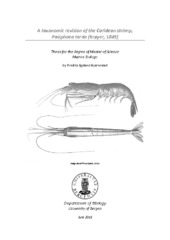A taxonomic revision of the Caridean shrimp, Pasiphaea tarda (Krøyer, 1845)
Abstract
The taxonomic status of the Caridean shrimp, Pasiphaea tarda (Krøyer, 1845), has been a matter of debate throughout the years, and various authors have argued whether or not P. princeps and P. principalis should be synonymized with P. tarda. A preliminary phylogenetic NJ tree placing Atlantic sequences in a group distinct from Pacific sequences has added to the dispute. DNA were extracted from Pacific and Atlantic specimens and sequenced for the mitochondrial cytochrome c oxidase subunit 1 gene (COI). The sequences were supplemented by Pasiphaeid sequences downloaded from GenBank and aligned. A phylogenetic tree was created using Maximum likelihood and the topology was confirmed with Bayesian inference. The tree indicated divergence between a monophyletic Atlantic lineage, and two distinct lineages in the Pacific. Nonetheless, K2P distances were in accordance with the populations belonging to the same species. ANOVAs conducted on morphological data found no significant (p>0.05) differences within the Atlantic Ocean. Substantiated by K2P distances, this indicates a homogenous population of P. tarda within the Atlantic. ANOVAs comparing the Pacific and Atlantic population found significant differences (p<0.05) between the two populations. The divergent morphology and the degree of genetic divergence between the Atlantic and Pacific populations indicate limited gene flow and that P. tarda is polytypic. The time of divergence was estimated to 1 mya, and was calculated using Bayesian inference and a mutation rate of 0.014/Myr. Failing to identify any distinguishing morphological characters of taxonomic importance between P. princeps and P. tarda prompts a synonymization of the two taxa.
